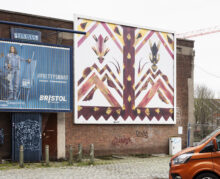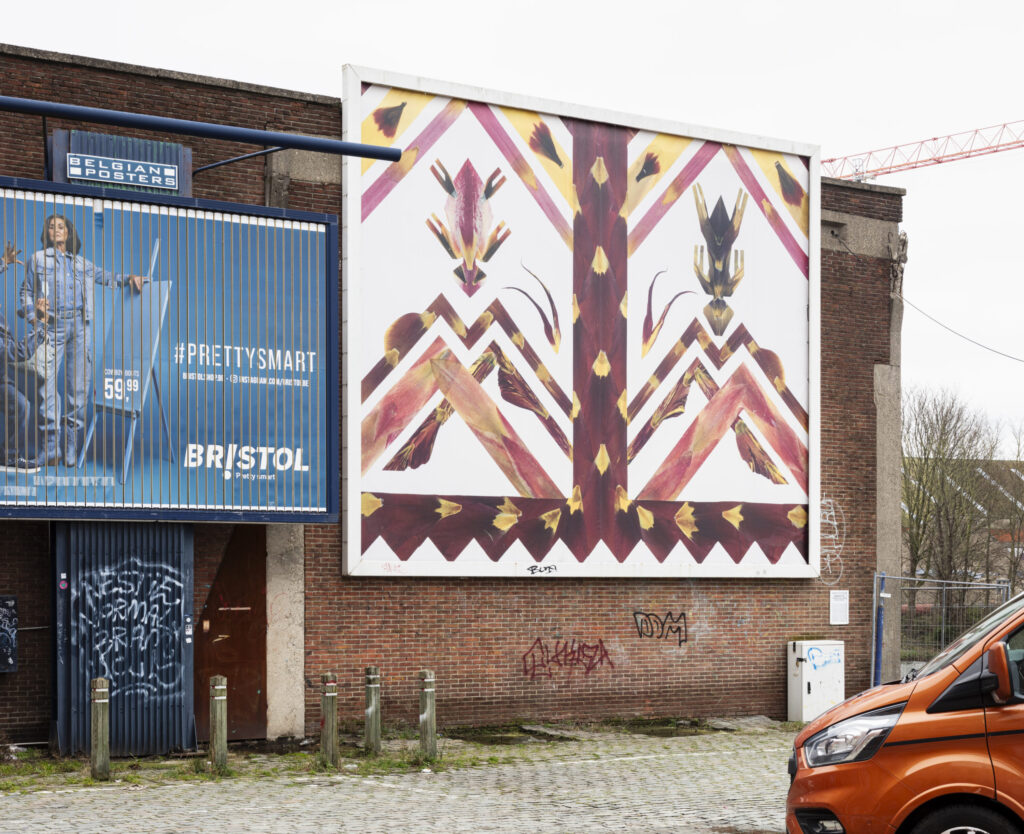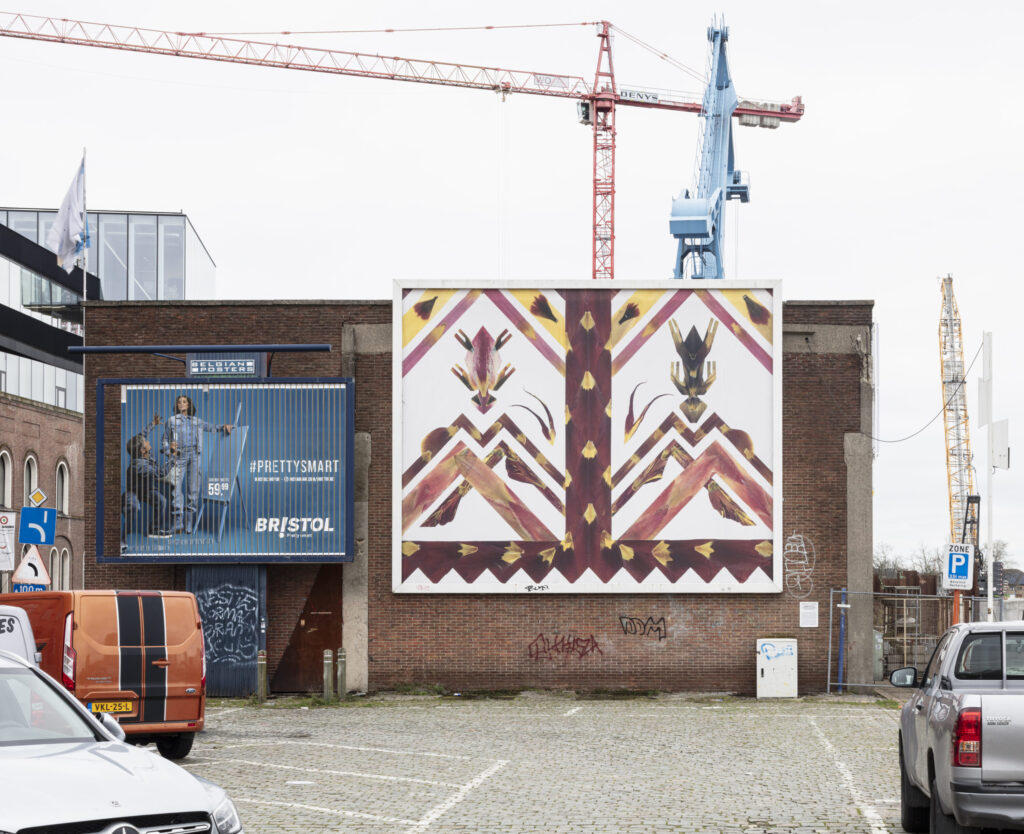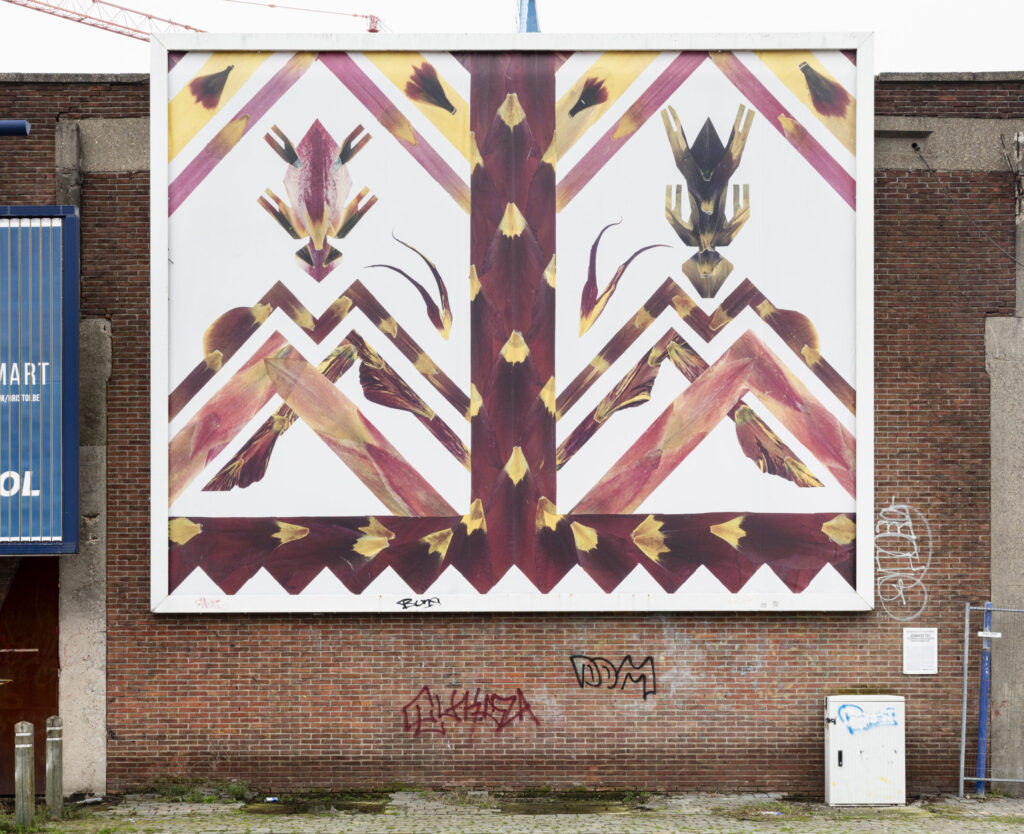JENNIFER TEE
Tampan Chelonian Creatures #2
27/02/2024 – 23/06/2024

Jennifer Tee (° 1973, NL) probeert de mensheid te situeren binnen de immense context van het universum. Ze is zich ervan bewust dat de menselijke cultuur slechts een klein onderdeel is van het geheel van wezens dat deze wereld bewoont.Tee duikt in de complexiteit van het bestaan met diep begrip van de onderlinge verbondenheid tussen soorten, culturen en tijdperken. Door te kijken naar wat voorafging en wat nog komt als overlappende lagen in plaats van afzonderlijke tijdperken, maakt Tee nieuwe manieren van begrip mogelijk van een steeds complexere wereld.
De keramische koepels, gebreide vloerstukken, wandtapijten gemaakt bladeren van de ananasplant, en tulpen-collages van Jennifer Tee richten allemaal de aandacht op de delicate wisselwerking tussen natuur en cultuur, taal en perceptie, schoonheid en vernietiging. Ze gaan in op hoe deze concepten zich verhouden tot kwesties als grondrecht, nationaliteit, identiteit en ecologie. Gecombineerd in tentoonstellingen vormen al deze werken fantasierijke omgevingen, die Tee af en toe activeert door middel van voordrachten met dichters en schrijvers, of door middel van performances waarbij de uitvoerders doeken worden voor haar textiele sculpturen en ze tot leven brengen. Het werk van Jennifer Tee verlangt ernaar de relatie van de mensheid met de natuurlijke wereld en het universum te herdefiniëren. Het moedigt ons aan om een meer gewortelde houding aan te nemen en de ecologische tijd en onze plaats daarin te omarmen.
Jennifer Tee is Nederlands met Sino-Indonesische roots, en in haar Tampan Tulip-werken verweeft ze herkenbare nationale symbolen van beide plekken. collages van gedroogde tulpenblaadjes zijn geïnspireerd op Indonische tampans. Tulpen zijn natuurlijk het bekendste symbool van Nederland en vertegenwoordigen een grote industrie en inkomstenbron. Indonesische tampans zijn ceremoniële textielstukken die worden tentoongesteld tijdens belangrijke momenten zoals geboortes of huwelijken. De tampans beelden vaak een schip af met mensen, planten en dieren aan boord. Hoewel de schepen in deze tampans Indonesische handelsschepen voorstellen, kunnen ze natuurlijk ook op een spirituele manier worden geïnterpreteerd. Soms wordt het schip gezien als de doorgang naar een hiernamaals. Deze dubbele visie op geschiedenis en spiritualiteit is zeer aanwezig in het werk van Tee. De manier waarop de kunstenaar haar tampans creëert, is dan ook een proces dat onderzoek en intuïtie met elkaar verweeft.
Voor dit specifieke billboard maakte Tee een diptiek genaamd Tampan Chelonian Creatures #2. Chelonia is de wetenschappelijke naam die wordt gegeven aan schildpadden, landschildpadden en terrapins. Op het billboard van Tee vinden we figuren die lijken op schildpadden. Tee wilde echter dat ze er anders uitzagen dan een echte schildpad, dus gaf ze gespleten vinnen en langgerekte koppen. Dit geeft de schildpaddenfiguren een mythisch aspect, misschien verbonden met folkloristische wezens van de zee. Voor Tampan Chelonian Creatures #2 wilde Tee zich richten op het dubbele visuele element van de mast van een schip of de levensboom. De figuren worden gescheiden door een donkerroze streep met kleinere lijnen die daarvan vertakken. Als we de centrale streep zien als de levensboom, zou dit kunnen wijzen op de verwantschap tussen mensen en alle andere wezens, zoals de chelonische figuren van Tee. Als we echter de streep zien als de mast van een schip, vinden we een sterke verbinding met de oceaan en kunnen we ons een oceaansetting voorstellen. Het werk spreekt van verbondenheid. Als wezens die evolueren, maken we allemaal deel uit van een lange geschiedenis die een ecologische tijdlijn volgt. Op dezelfde manier wordt Gent doorkruist door de rivieren Leie en Schelde. Deze rivieren bereiken uiteindelijk de oceaan. Water circuleert de planeet en het water dat je hier ziet bij Dok Noord is waarschijnlijk ook tussen de vele Indonesizche eilanden gegaan. Misschien zijn we dichter bij schildpadden dan men zou denken.
Jennifer Tee (°1973, NL) attempts to situate mankind within the vast context of the universe. Tee is aware that human culture is only a small part of the constellation of beings that inhabit this world. She delves into the complexities of existence with a profound understanding of the interconnectivity between species, cultures and time periods. By seeing what came before and what comes after as overlapping layers rather than distinct eras, Tee allows new ways of understanding an increasingly complex world.
Tee’s ceramic spheres, knitted floor pieces, pineapple cloth tapestries and tulip collages all direct attention to the delicate interplay between nature and culture, language and perception, beauty and destruction. They delve into how these concepts intersect with issues of land rights, nationality, belonging, and ecology. Combined in exhibitions, all these works form imaginative environments, which Tee occasionally activates through readings with poets and writers, or through performance in which the performers bring her textile sculptures to life. These participations foster their own unique rituals. They blur the boundaries between reality and an imagined world, merging physically and mentally, serving as a powerful metaphorical connection. Jennifer Tee’s work yearns to redefine humanity’s relationship with the natural world and the cosmos. It encourages us to adopt a more rooted, immovable stance, embracing ecological time and our place within it.
Jennifer Tee is Dutch with Chinese-Indonesian roots, and in the Tampan Tulip works, she intertwines two recognisable national symbols. Tulips are the national symbol of the Netherlands, and represent a vast industrie and important source of income. Tee’s collages of cut-up tulip petals are inspired by Indonesian tampans from the Sumatra island. These ceremonial textiles that are used during important moments such as births or marriages. The tampans often depict a ship with humans, plants and animals aboard it. Sometimes the mast of the ship can be in the form of a tree, representing the tree of life. While the ships could be a woven representation of Indonesian trade ships, they can also be interpreted in a spiritual sense. Sometimes, this ship is seen as the passage to an after-life.
This double-vision of history and spirituality is very present in Tee’s work. The way that Tee creates her tampans is a process that intertwines research and intuition. The colours of tulips that Tee uses in her work depend on the seasons and what the harvest yields. She works primarily with Rembrandt tulips which have streaked petals. Not only do the Rembrandt tulips offer an extra patterned visual element in her collages, the tulips are also associated as well with another Dutch icon, painter Rembrandt van Rijn.
For this particular billboard, Tee made a diptych called Tampan Chelonian Creatures #2. Chelonian is the scientific name given to turtles, tortoises, and terrapins. In Tee’s billboard, we can find figures that resemble turtles. However, Tee wanted them to look different from a real-life turtle, so she gave them split fins and elongated heads. This gives the turtle figures a mythical aspect, perhaps linking them to folkloric creatures of the sea.
For Tampan Chelonian Creatures #2, Tee wanted to focus on the dual visual element of the mast of a ship or the tree of life. The figures are separated by a dark pink stripe that has smaller lines branching off. If we see the central stripe as the tree of life, it could be hinting towards the kinship between humans and all other creatures such as Tee’s Chelonian ones. However, if we read the stripe as the mast of a ship, we can find a strong connection to the ocean and could imagine an ocean setting. The work speaks of connectivity. As creatures that evolve, we are all part of a long history that follows an ecological timeline. Similarly, Ghent is crossed through by the rivers Leie and Scheldt. These rivers eventually reach the ocean. Water circulates the planet and the water you see here at Dok Noord probably passed through the many Indonesian islands as well. Perhaps we are closer to turtles than one would think.
Text: Max Ferguson



